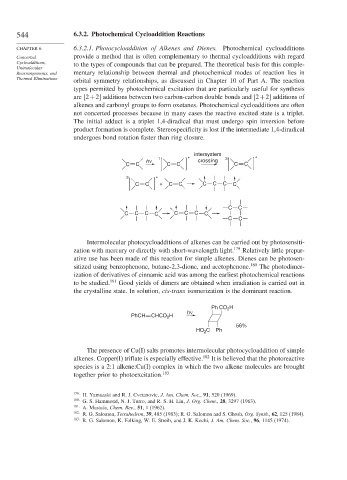Page 570 - Advanced Organic Chemistry Part B - Reactions & Synthesis
P. 570
544 6.3.2. Photochemical Cycloaddition Reactions
CHAPTER 6 6.3.2.1. Photocycloaddition of Alkenes and Dienes. Photochemical cycloadditions
Concerted provide a method that is often complementary to thermal cycloadditions with regard
Cycloadditions, to the types of compounds that can be prepared. The theoretical basis for this comple-
Unimolecular
Rearrangements, and mentary relationship between thermal and photochemical modes of reaction lies in
Thermal Eliminations
orbital symmetry relationships, as discussed in Chapter 10 of Part A. The reaction
types permitted by photochemical excitation that are particularly useful for synthesis
are 2+2 additions between two carbon-carbon double bonds and 2+2 additions of
alkenes and carbonyl groups to form oxetanes. Photochemical cycloadditions are often
not concerted processes because in many cases the reactive excited state is a triplet.
The initial adduct is a triplet 1,4-diradical that must undergo spin inversion before
product formation is complete. Stereospecificity is lost if the intermediate 1,4-diradical
undergoes bond rotation faster than ring closure.
intersystem
h ν 1 * crossing 3 *
C C C C C C
3 *
C C + C C C C C C
C C
C C C C C C C C
C C
Intermolecular photocycloadditions of alkenes can be carried out by photosensiti-
zation with mercury or directly with short-wavelength light. 179 Relatively little prepar-
ative use has been made of this reaction for simple alkenes. Dienes can be photosen-
sitized using benzophenone, butane-2,3-dione, and acetophenone. 180 The photodimer-
ization of derivatives of cinnamic acid was among the earliest photochemical reactions
to be studied. 181 Good yields of dimers are obtained when irradiation is carried out in
the crystalline state. In solution, cis-trans isomerization is the dominant reaction.
Ph CO H
2
h ν
PhCH CHCO H
2
56%
HO 2 C Ph
The presence of Cu(I) salts promotes intermolecular photocycloaddition of simple
alkenes. Copper(I) triflate is especially effective. 182 It is believed that the photoreactive
species is a 2:1 alkene:Cu(I) complex in which the two alkene molecules are brought
together prior to photoexcitation. 183
179 H. Yamazaki and R. J. Cvetanovic, J. Am. Chem. Soc., 91, 520 (1969).
180
G. S. Hammond, N. J. Turro, and R. S. H. Liu, J. Org. Chem., 28, 3297 (1963).
181
A. Mustafa, Chem. Rev., 51, 1 (1962).
182 R. G. Salomon, Tetrahedron, 39, 485 (1983); R. G. Salomon and S. Ghosh, Org. Synth., 62, 125 (1984).
183
R. G. Salomon, K. Folking, W. E. Streib, and J. K. Kochi, J. Am. Chem. Soc., 96, 1145 (1974).

